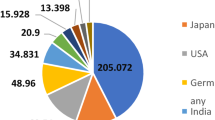Abstract
This paper proposes an effective fusion of neural networks and grey modeling for adaptive electricity load forecasting. The fusion employs the complementary strength of these two appealing techniques. In terms of forecasting accuracy, the proposed fusion scheme outperforms the individual ones and the statistical autoregressive methods according to the results of a substantial number of experiments. In addition to the fusion scheme, this paper also proposes a grey relational analysis to automatically assess the importance of each input variable for the forecasting task. This analysis helps the forecaster choose dominant ones among the many input variables, thus removing much burden of acquiring professional domain knowledge for problems and reducing the interference of irrelevant inputs on the forecasting. Experimental results are shown in this paper to verify the effectiveness of the grey relational analysis.






Similar content being viewed by others
References
Hippert HS, Pedreira CE, Souza RC (2001) Neural networks for short-term load forecasting: a review and evaluation. IEEE Trans Power Syst 16(1):44–55
Liang RH, Cheng CC (2000) Combined regression-fuzzy approach for short-term load forecasting. IEE P-Gener Transm D 147(4):261–266
Srinivasan D, Tan SS, Chang CS, Chan EK (1999) Parallel neural network-fuzzy expert system strategy for short-term load forecasting: System implementation and performance evaluation. IEEE Trans Power Syst 14(3):1100–1105
Chiu CC, Kao LJ, Cook DF (1997) Combining a neural network with a rule-based expert system approach for short-term power load forecasting in taiwan. Expert Syst Appl 13(4):299–305
Hsu CC, Chen CY (2003) Regional load forecasting in Taiwan—applications of artificial neural networks. Energ Convers Manage 44(12):1941–1949
Ganjavi MR, Lucas C, Javidi MH (1999) Short term load forecasting using fuzzy neural network modified by the similarity and subsethood measures. J Intell Fuzzy Syst 7(4):347–357
Papadakis SE, Theocharis JB, Kiartzis SJ, Bakirtzis AG (1998) A novel approach to short-term load forecasting using fuzzy neural networks. IEEE Trans Power Syst 13(2):480–489
He SH, Li XY, Zhong J (2002) Identification of armax based on genetic algorithm. Trans Nonferrous Metals Soc China 12(2):349–355
Yang HT, Huang CM, Huang CL (1996) Identification of armax model for short term load forecasting: an evolutionary programming approach. IEEE Trans Power Syst 11(1):403–408
Amjady N (2001) Short-term hourly load forecasting using time-series modeling with peak load estimation capability. IEEE Trans Power Syst 16(4):798–805
Lin CB, Su SF, Hsu YT (2001) High-precision forecast using grey models. Int J Syst Sci 32(5):609–619
Luo YX, Zhang LT, Cai AH, He ZM (2004) Grey gm(1,1) model with function-transfer method and application to energy consuming prediction. Kybernetes 33(2):322–330
Tan JQ, Xie ZH, Ji LR (2003) A new way to predict forecast skill. Adv Atmos Sci 20(5):837–841
Yao AWL, Chi SC, Chen JH (2003) An improved grey-based approach for electricity demand forecasting. Electric Power Syst Res 67(3):217–224
Yu PS, Chen CJ, Chen SJ, Lin SC (2001) Application of grey model toward runoff forecasting. J Am Water Resource Assoc 37(1):151–166
Ranaweera DK, Hubele NF, Karady GG (1996) Fuzzy logic for short term load forecasting. Int J Elec Power Energ Syst 18(4):215–222
Chen JF, Wang WM, Huang CM (1995) Analysis of an adaptive time-series autoregressive moving-average (arma) model for short-term load forecasting. Elec Pow Syst Res 34(3):187–196
Nowicka-Zagrajek J, Weron R (2002) Modeling electricity loads in california: Arma models with hyperbolic noise. Signal Process 82(12):1903–1915
Ranaweera DK, Karady GG, Farmer RG (1997) Economic impact analysts of load forecasting. IEEE Trans Power Syst 12(3):1388–1392
Douglas AP, Breipohl AM, Lee FN, Adapa R (1998) Risk due to load forecast uncertainty in short term bower system planning. IEEE Trans Power Syst 13(4):1493–1499
Hobbs BF, Jitprapaikulsarn S, Konda S, Chankong V, Loparo KA, Maratukulam DJ (1999) Analysis of the value for unit commitment of improved load forecasts. IEEE Trans Power Syst 14(4):1342–1348
Bunn DW (2000) Forecasting loads and prices in competitive power markets. Proc IEEE 88(2):163–169
Nahmias S (1997) Production and operations analysis, 3rd edn. Chap 2, Forecasting. McGraw-Hill, New York
Pollock D, Green R, Nugyen T (1999) Handbook of time series analysis, signal processing, and dynamics. Academic, San Diego, Bk&CD-Rom edn
Viswanathan V, Krishnan V, Tsoukalas LH (1999) Novel ai approaches in power systems. In: 1999 International conference on information intelligence and systems. Rockville, Maryland, pp 275–280
Perrone MP, Cooper LN (1993) When networks disagree: ensemble methods for hybrid neural networks. In: Mammone RJ (ed) Neural networks for speech and image processing. Chapman-Hall, London, pp 126–142
Hashem S, Schmeiser B (1995) Natural gas load forecasting with combination of adaptive. IEEE Trans Neural Networ 6(3):792–794
Elragal H, Khotanzad A (1999) Natural gas load forecasting with combination of adaptive. In: Proceedings of the international joint conference on neural networks, pp 4069–4072
Deng JL (1989) Introduction to grey system theory. Syst Control Lett 5(1):1–24
Huang SJ, Huang CL (2000) Control of an inverted pendulum using grey prediction model. IEEE Trans Ind Appl 36(2):452–458
Su SF, Lin CB, Hsu YT (2002) A high precision global prediction approach based on local prediction approaches. IEEE Trans Syst Man Cybern C Appl Rev 32(4):416–425
Bellman R (1961) Adaptive control processes: a guided tour. Princeton University Press, Princeton
Author information
Authors and Affiliations
Corresponding author
Rights and permissions
About this article
Cite this article
Chiang, CC., Ho, MC. & Chen, JA. A hybrid approach of neural networks and grey modeling for adaptive electricity load forecasting. Neural Comput & Applic 15, 328–338 (2006). https://doi.org/10.1007/s00521-006-0031-4
Received:
Accepted:
Published:
Issue Date:
DOI: https://doi.org/10.1007/s00521-006-0031-4




